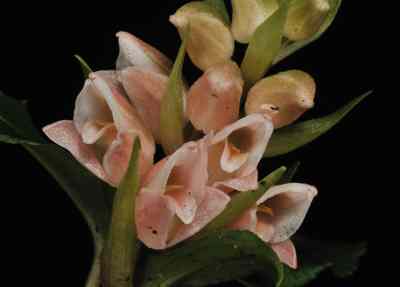The Plant
Terrestrial, whole plant 15 to 25 cm in height. With 3 to 4 irregular tubers with many hairy long roots arising from it, cylindrical to oblong, 1 to 2.5 cm long. Stem cylindrical with many leaves laxly arranged all along the stems. Leaves unequal, linear, acute, sessile, clasping but not fully covering at its base, 9 to 3 cm long, diminishing in length towards the apex of the stem. Flower many in a spike, longer than the stem.
The Flower
Flower 1.25 cm across. Sepals unequal, dorsal ovate, as long as the lateral sepals; lateral sepals, and petals lanceolate; all connivent to form a diagonally curved up hood. Lip longer than the sepals and petals, decurved, apex three lobed, the middle one longer than the other two, oblong with broad base; side ones slightly diverging, oblong with its outer margin bottle nose shaped. Spur like a funnel, much broader at its apex and converging to a cylindrical blunt apex. Floral bracts lanceolate, longer than the ovary, arising from the lower side of the erect ovary.
Sepals pale pink to rose flushed with white. Petals and lip of a darker shade with the base of the latter white with several elongated markings of the same shade. Spur pale pink, translucent. Floral bracts green.

The Pursuit
A species that was not reported by King and Pantling in their monumental work. This species was discovered later on by W. W. Smith, another botanist who explored the Himalayas. After his work many botanists including Indian researchers worked in the region and even came out with publications. But none of those works produced any documentary evidence of this species. Hence I was not sure whether this species actually existed in this region.
With the work on Alpine region I covered several hundred square kilometers on foot finding and documenting several species from the region, many were the first ever-photographic evidence of those particular species. As it was my first survey work in the higher altitudes, wherever I went I found various species.
After a meticulous survey I was able to locate another rare species that is very similar to this species. While I was making notes, I remembered this species and thought about the possibilities of finding it. The search for this species was never ending and it was almost the end of the flowering season. As I was returning in the evening from a survey trip in a government vehicle I noticed few very small plants with pink flowers. I was not sure what species it was. However, I noticed its leaf pattern and was sure it is not the same I had found earlier. The driver of that vehicle was not so cooperative and was reluctant to stop. Understanding his attitudes I decided to come the next day to take a closer look of the species. Next day I took another vehicle and went to the location. For around half an hour I was not able to locate those small plants. After a thorough search that helped me in locating one more rare species, I found this species again. Altogether they were five plants of this species. The plants were with many buds and more than half of them already open. Without much difficulty I made neat drawings and photographs.
Reference:
There is no reference of this species in The Orchids of the Sikkim-Himalayas by Sir. George King and Robert Pantling (1898).







